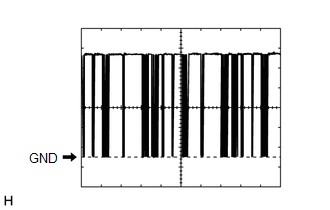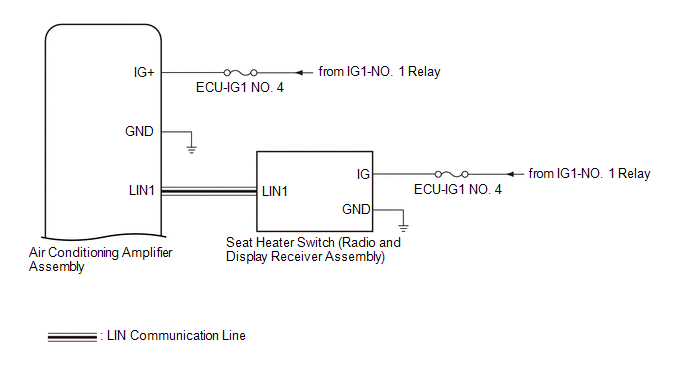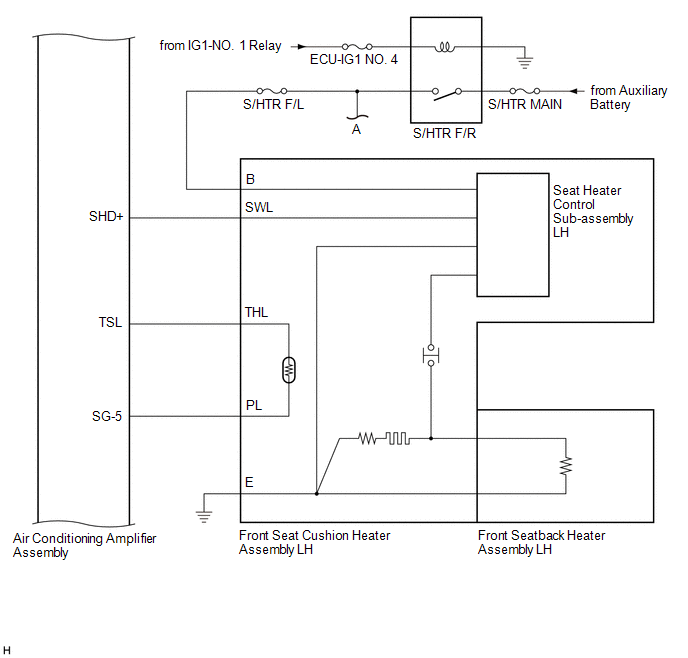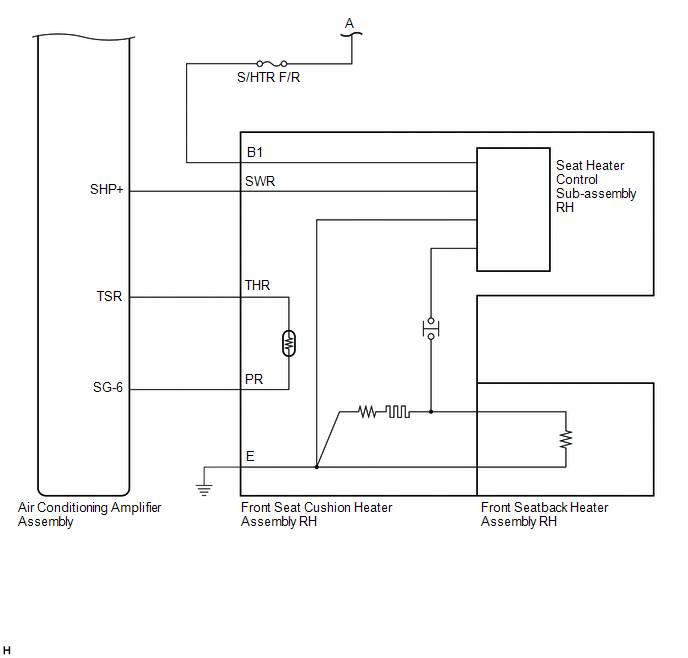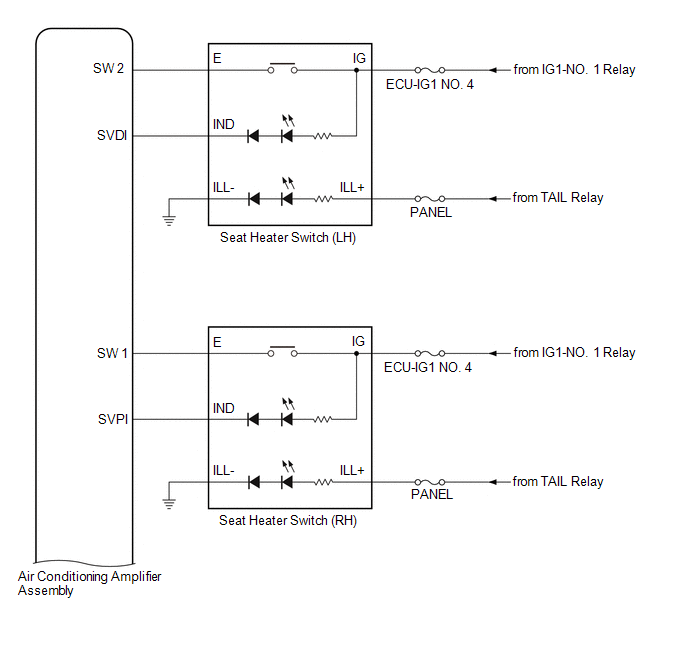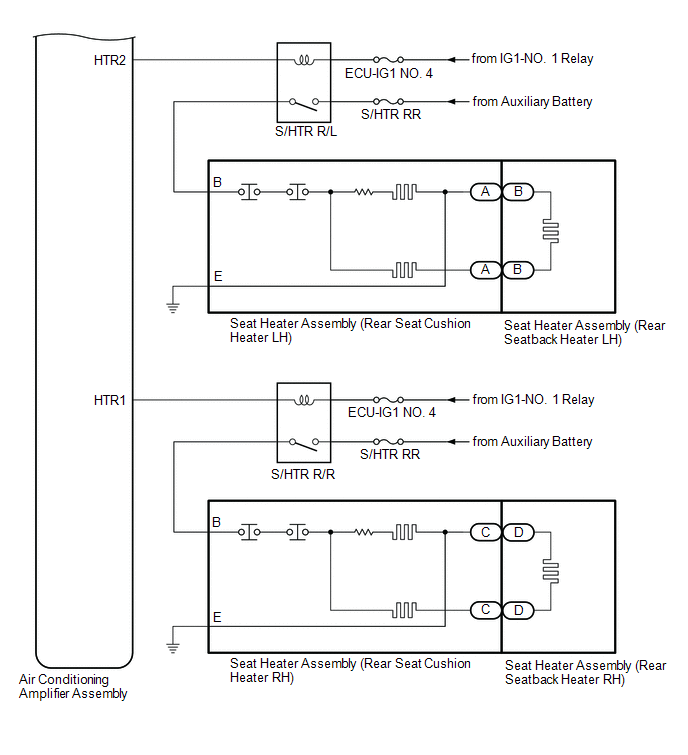Lost Communication with Front Seat Temperature Adjustment Switch LIN (B14B5)
DESCRIPTION
The seat heater
switch (radio and display receiver assembly) communicates with the air
conditioning amplifier assembly via LIN communication.
If
the LIN communication system is malfunctioning, the air conditioning
amplifier assembly will not operate even if the seat heater switch
(radio and display receiver assembly) is operated.
|
DTC No. | Detection Item |
DTC Detection Condition | Trouble Area |
|
B14B5 | Lost Communication with Front Seat Temperature Adjustment Switch LIN |
Lost communication with the seat heater switch (radio and display receiver assembly) |
- Seat heater switch (radio and display receiver assembly)
- Air conditioning amplifier assembly
- Wire harness or connector
- ECU-IG1 NO. 4 fuse
|
WIRING DIAGRAM
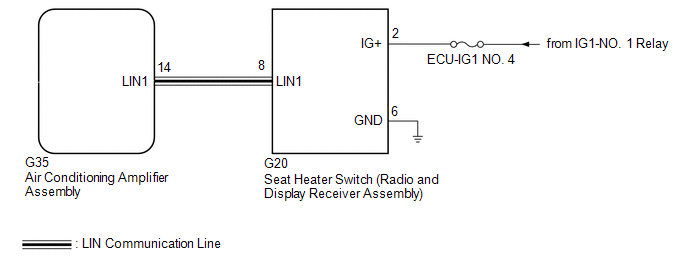
CAUTION / NOTICE / HINT
NOTICE:
Inspect the fuses for circuits related to this system before performing the following procedure.
PROCEDURE
(a) Clear the DTCs.
Click here

Body Electrical > Air Conditioner > Clear DTCs
|
NEXT |
 | |
(a) Check for DTCs.
Click here 
Body Electrical > Air Conditioner > Trouble Codes
OK:
DTC B14B5 is not output.
| OK |
 | USE SIMULATION METHOD TO CHECK |
|
NG |
 | |
| 3. |
CHECK HARNESS AND CONNECTOR (IG POWER SUPPLY - SEAT HEATER SWITCH (RADIO AND DISPLAY RECEIVER ASSEMBLY) - BODY GROUND) |
| (a) Disconnect the G20 seat heater switch (radio and display receiver assembly) connector. |
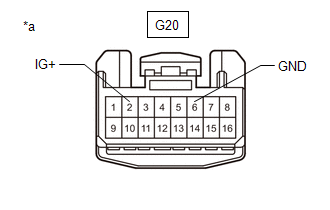 |
|
*a | Front view of wire harness connector
(to Seat Heater Switch (Radio and Display Receiver Assembly)) | | |
(b) Measure the voltage and resistance according to the value(s) in the table below.
Standard Voltage:
|
Tester Connection | Condition |
Specified Condition |
|
G20-2 (IG+) - Body ground |
Power switch on (IG) |
11 to 14 V |
|
G20-2 (IG+) - Body ground |
Power switch off | Below 1 V |
Standard Resistance:
|
Tester Connection | Condition |
Specified Condition |
|
G20-6 (GND) - Body ground |
Always | Below 1 Ω |
| NG |
 | REPAIR OR REPLACE HARNESS OR CONNECTOR |
|
OK |
 | |
| 4. |
CHECK HARNESS AND CONNECTOR (AIR CONDITIONING AMPLIFIER ASSEMBLY - SEAT HEATER SWITCH (RADIO AND DISPLAY RECEIVER ASSEMBLY)) |
(a) Disconnect the G35 air conditioning amplifier assembly connector.
(b) Measure the resistance according to the value(s) in the table below.
Standard Resistance:
|
Tester Connection | Condition |
Specified Condition |
|
G35-14 (LIN1) - G20-8 (LIN1) |
Always | Below 1 Ω |
|
G35-14 (LIN1) or G20-8(LIN1) - Body ground |
Always | 10 kΩ or higher |
| NG |
 | REPAIR OR REPLACE HARNESS OR CONNECTOR |
|
OK |
 | |
| 5. |
INSPECT AIR CONDITIONING AMPLIFIER ASSEMBLY |
| (a) Connect the G35 air conditioning amplifier assembly connector. |
|
(b) Turn the power switch on (IG).
(c) Using an oscilloscope, check the waveform.
OK:
Waveform is similar to that shown in the illustration.
|
Item | Content |
|
Terminal No. | G35-14 (LIN1) - Body ground |
|
Tool Setting | 2 V/DIV., 20 ms./DIV. |
|
Condition | Power switch on (IG) |
| NG |
 | REPLACE AIR CONDITIONING AMPLIFIER ASSEMBLY |
|
OK |
 | |
| 6. |
INSPECT SEAT HEATER SWITCH (RADIO AND DISPLAY RECEIVER ASSEMBLY) |
| (a) Connect the G20 seat heater switch (radio and display receiver assembly) connector. |
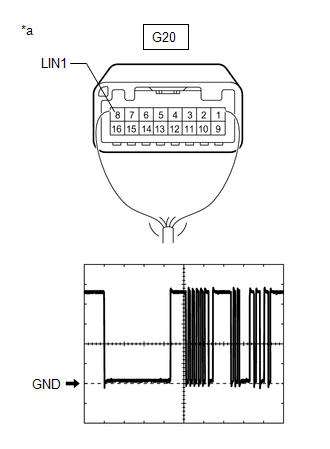 |
|
*a | Component with harness connected
(Seat Heater Switch (Radio and Display Receiver Assembly)) | | |
(b) Turn the power switch on (IG).
(c) Using an oscilloscope, check the waveform.
|
Item | Content |
|
Terminal No. | G20-8 (LIN1) - Body ground |
|
Tool Setting | 2 V/DIV., 20 ms./DIV. |
|
Condition | Power switch on (IG) |
OK:
Waveform is similar to that shown in the illustration.
| OK |
 | REPLACE AIR CONDITIONING AMPLIFIER ASSEMBLY |
| NG |
 | REPLACE SEAT HEATER SWITCH (RADIO AND DISPLAY RECEIVER ASSEMBLY) |
Front Right Seat Heat Sensor Circuit (B14C0)
DESCRIPTION
Output to the
front seat cushion heater temperature sensor stops if one of the
following occurs: 1) the temperature sensor is open or shorted; or 2)
the temperature sensor is damaged and its output value does not change.
|
DTC No. | Detection Item |
DTC Detection Condition | Trouble Area |
|
B14C0 | Front Right Seat Heat Sensor Circuit |
Seat heater temperature sensor malfunction |
- Air conditioning amplifier assembly
- Front seat cushion heater assembly RH
- Wire harness or connector
|
WIRING DIAGRAM

PROCEDURE
(a) Clear the DTCs.
Click here

Body Electrical > Air Conditioner > Clear DTCs
|
NEXT |
 | |
(a) Check for DTCs.
Click here 
Body Electrical > Air Conditioner > Trouble Codes
OK:
DTC B14C0 is not output.
| OK |
 | USE SIMULATION METHOD TO CHECK |
|
NG |
 | |
| 3. |
INSPECT FRONT SEAT CUSHION HEATER ASSEMBLY RH |
(a) Disconnect the R6 front seat cushion heater assembly RH connector.
| (b) Measure the resistance according to the value(s) in the table below.
Standard Resistance: |
Tester Connection | Condition |
Specified Condition | |
R6-4 (THR) - R6-5 (PR) |
Seat heater temperature 25°C (77°F) |
9.5 to 10.5 kΩ | |
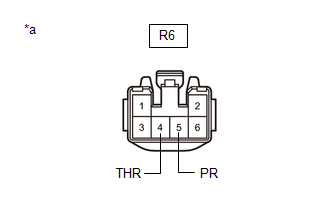 |
|
*a | Component without harness connected
(Front Seat Cushion Heater Assembly RH) | | |
| NG |
 | REPLACE FRONT SEAT CUSHION HEATER ASSEMBLY RH |
|
OK |
 | |
| 4. |
CHECK HARNESS AND CONNECTOR (AIR CONDITIONING AMPLIFIER ASSEMBLY - FRONT SEAT CUSHION HEATER ASSEMBLY RH) |
(a) Disconnect the G37 air conditioning amplifier assembly connector.
(b) Measure the resistance according to the value(s) in the table below.
Standard Resistance:
|
Tester Connection | Condition |
Specified Condition |
|
G37-18 (TSR) - R6-4 (THR) |
Always | Below 1 Ω |
|
G37-18 (TSR) or R6-4 (THR) - Body ground |
Always | 10 kΩ or higher |
|
G37-9 (SG-6) - R6-5 (PR) |
Always | Below 1 Ω |
|
G37-9 (SG-6) or R6-5 (PR) - Body ground |
Always | 10 kΩ or higher |
| OK |
 | REPLACE AIR CONDITIONING AMPLIFIER ASSEMBLY |
| NG |
 | REPAIR OR REPLACE HARNESS OR CONNECTOR |
Front Left Seat Heat Sensor Circuit (B14C1)
DESCRIPTION
Output to the
front seat cushion heater temperature sensor stops if one of the
following occurs: 1) the temperature sensor is open or shorted; or 2)
the temperature sensor is damaged and its output value does not change.
|
DTC No. | Detection Item |
DTC Detection Condition | Trouble Area |
|
B14C1 | Front Left Seat Heat Sensor Circuit |
Seat heater temperature sensor malfunction |
- Air conditioning amplifier assembly
- Front Seat Cushion Heater Assembly LH
- Wire harness or connector
|
WIRING DIAGRAM
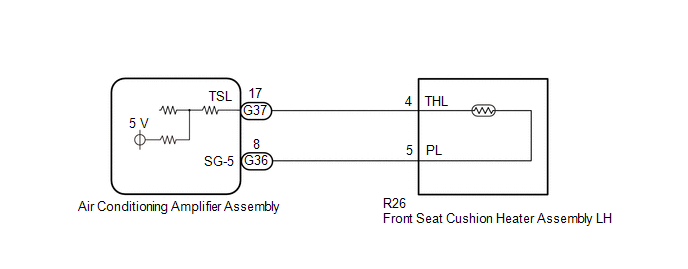
PROCEDURE
(a) Clear the DTCs.
Click here

Body Electrical > Air Conditioner > Clear DTCs
|
NEXT |
 | |
(a) Check for DTCs.
Click here 
Body Electrical > Air Conditioner > Trouble Codes
OK:
DTC B14C1 is not output.
| OK |
 | USE SIMULATION METHOD TO CHECK |
|
NG |
 | |
| 3. |
INSPECT FRONT SEAT CUSHION HEATER ASSEMBLY LH |
(a) Disconnect the R26 front seat cushion heater assembly LH connector.
| (b) Measure the resistance according to the value(s) in the table below.
Standard Resistance: |
Tester Connection | Condition |
Specified Condition | |
R26-4 (THL) - R26-5 (PL) |
Seat heater temperature 25°C (77°F) |
9.5 to 10.5 kΩ | |
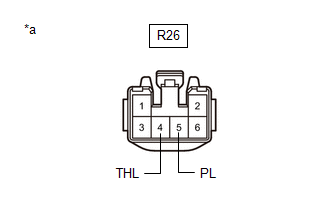 |
|
*a | Component without harness connected
(Front Seat Cushion Heater Assembly LH) | | |
| NG |
 | REPLACE FRONT SEAT CUSHION HEATER ASSEMBLY LH |
|
OK |
 | |
| 4. |
CHECK HARNESS AND CONNECTOR (AIR CONDITIONING AMPLIFIER ASSEMBLY - FRONT SEAT CUSHION HEATER ASSEMBLY LH) |
(a) Disconnect the G36 and G37 air conditioning amplifier assembly connectors.
(b) Measure the resistance according to the value(s) in the table below.
Standard Resistance:
|
Tester Connection | Condition |
Specified Condition |
|
G37-17 (TSL) - R26-4 (THL) |
Always | Below 1 Ω |
|
G37-17 (TSL) or R26-4 (THL) - Body ground |
Always | 10 kΩ or higher |
|
G36-8 (SG-5) - R26-5 (PL) |
Always | Below 1 Ω |
|
G36-8 (SG-5) or R26-5 (PL) - Body ground |
Always | 10 kΩ or higher |
| OK |
 | REPLACE AIR CONDITIONING AMPLIFIER ASSEMBLY |
| NG |
 | REPAIR OR REPLACE HARNESS OR CONNECTOR |
Data List / Active Test
DATA LIST / ACTIVE TEST
DATA LIST
NOTICE:
In
the following table, the values listed under "Normal Condition" are
reference values. Do not depend solely on these reference values when
deciding whether a part is faulty or not.
HINT:
Using
the Techstream to read the Data List allows the values or states of
switches, sensors, actuators and other items to be read without removing
any parts. This non-intrusive inspection can be very useful because
intermittent conditions or signals may be discovered before parts or
wiring is disturbed. Reading the Data List information early in
troubleshooting is one way to save diagnostic time.
(a) Connect the Techstream to the DLC3.
(b) Turn the power switch on (IG).
(c) Turn the Techstream on.
(d) Enter the following menus: Body Electrical / Air Conditioner / Data List.
(e) Read the Data List according to the display on the Techstream.
Body Electrical > Air Conditioner > Data List
|
Tester Display | Measurement Item |
Range | Normal Condition |
Diagnostic Note |
|
FR Seat Heater Temperature |
Front seat RH side seat heater temperature |
-29.7°C to 59.55°C | Within range from 36 to 44°C (96.8 to 111.2°F) |
Front seat heater is on |
|
FL Seat Heater Temperature |
Front seat LH side seat heater temperature |
-29.7°C to 59.55°C | Within range from 36 to 44°C (96.8 to 111.2°F) |
Front seat heater is on |
|
Number of Trouble Codes |
Number of trouble codes |
0 to 255 | Number of DTCs will be displayed |
- |
ACTIVE TEST
HINT:
Using
the Techstream to perform Active Tests allows relays, VSVs, actuators
and other items to be operated without removing any parts. This
non-intrusive functional inspection can be very useful because
intermittent operation may be discovered before parts or wiring is
disturbed. Performing Active Tests early in troubleshooting is one way
to save diagnostic time. Data List information can be displayed while
performing Active Tests.
(a) Connect the Techstream to the DLC3.
(b) Turn the power switch on (IG).
(c) Turn the Techstream on.
(d) Enter the following menus: Body Electrical / Air Conditioner / Active Test.
(e) Perform the Active Test according to the display on the Techstream.
Body Electrical > Air Conditioner > Active Test
|
Tester Display | Measurement Item |
Control Range | Diagnostic Note |
|
Front Right Seat Heater |
Front seat RH side seat heater operation |
OFF or ON | - |
|
Front Left Seat Heater |
Front seat LH side seat heater operation |
OFF or ON | - |
Diagnosis System
DIAGNOSIS SYSTEM
DESCRIPTION
(a)
Seat heater system data and Diagnostic Trouble Codes (DTCs) can be read
through the Data Link Connector 3 (DLC3) of the vehicle. When the
system seems to be malfunctioning, use the Techstream to check for
malfunctions and perform repairs.
CHECK DLC3
(a) Check the DLC3.
Click here 
INSPECT AUXILIARY BATTERY VOLTAGE
(a) Check the auxiliary battery voltage with the power switch.
Standard Voltage:
11 to 14 V
If the voltage is below 11 V, recharge or replace the auxiliary battery.
Diagnostic Trouble Code Chart
DIAGNOSTIC TROUBLE CODE CHART
Seat Heater System |
DTC No. | Detection Item |
Link |
| B14B5 |
Lost Communication with Front Seat Temperature Adjustment Switch LIN |
 |
|
B14C0 | Front Right Seat Heat Sensor Circuit |
 |
|
B14C1 | Front Left Seat Heat Sensor Circuit |
 |
Dtc Check / Clear
DTC CHECK / CLEAR
CHECK DTC
(a) Connect the Techstream to the DLC3.
(b) Turn the power switch on (IG).
(c) Turn the Techstream on.
(d) Enter the following menus: Body Electrical / Air Conditioner / Trouble Codes.
Body Electrical > Air Conditioner > Trouble Codes
(e) Check for DTCs.
CLEAR DTC
(a) Connect the Techstream to the DLC3.
(b) Turn the power switch on (IG).
(c) Turn the Techstream on.
(d) Enter the following menus: Body Electrical / Air Conditioner / Trouble Codes.
Body Electrical > Air Conditioner > Clear DTCs
(e) Clear the DTCs.
How To Proceed With Troubleshooting
CAUTION / NOTICE / HINT
HINT:
- Use the following procedure to troubleshoot the seat heater system.
- *: Use the Techstream.
PROCEDURE
|
1. | VEHICLE BROUGHT TO WORKSHOP |
|
NEXT |
 | |
| 2. |
CUSTOMER PROBLEM ANALYSIS |
(a) Interview the customer to confirm the problem.
Click here 
|
NEXT |
 | |
(a) Measure the auxiliary battery voltage with the power switch off.
Standard Voltage:
11 to 14 V
If the voltage is below 11 V, recharge or replace the auxiliary battery before proceeding to the next step.
(b) Check the fuses and relays.
(c)
Check the connector connections and terminals to make sure that there
are no abnormalities such as loose connections, deformation, etc.
|
NEXT |
 | |
(a) Clear the DTCs.
Body Electrical > Air Conditioner > Clear DTCs
(b) Check for DTCs.
Body Electrical > Air Conditioner > Trouble Codes
|
Result | Proceed to |
|
DTCs are not output | A |
|
Air conditioning system DTCs are output |
B |
| Seat heater system DTCs are output |
C |
| B |
 | GO TO AIR CONDITIONING SYSTEM |
| C |
 | GO TO DIAGNOSTIC TROUBLE CODE CHART |
|
A |
 | |
| 5. |
PROBLEM SYMPTOMS TABLE |
(a) Refer to Problem Symptoms Table.
Click here 
|
Result | Proceed to |
|
Fault is not listed in Problem Symptoms Table |
A |
| Fault is listed in Problem Symptoms Table |
B |
| B |
 | GO TO STEP 7 |
|
A |
 | |
| 6. |
OVERALL ANALYSIS AND TROUBLESHOOTING* |
(a) Operation Check
Click here 
(b) Terminals of ECU
Click here 
(c) Data List / Active Test
Click here 
(d) Inspection
|
NEXT |
 | |
|
NEXT |
 | |
| NEXT |
 | END |
Operation Check
OPERATION CHECK
CHECK FRONT SEAT HEATER
(a) Turn the power switch on (IG).
(b)
Turn the seat heater switch (radio and display receiver assembly) on
and check that the indicator illuminates and the surface of the front
seat warms up.
(c) Check that the front seat
surface temperature changes according to the operation of the seat
heater switch (radio and display receiver assembly) as follows: HI → MID
→ LO.
CHECK REAR SEAT HEATER (w/ Rear Seat Heater)
(a) Turn the power switch on (IG).
(b) Turn the seat heater switch on and check that the indicator illuminates and the surface of the rear seat warms up.
CHECK THERMOSTAT OF SEAT HEATER ASSEMBLY (REAR SEAT CUSHION HEATER LH) (w/ Rear Seat Heater)
(a) Remove the seat heater assembly (rear seat cushion heater LH).
Click here

(b) Remove the seat heater assembly (rear seatback heater LH).
Click here 
(c)
Connect the B seat heater assembly (rear seatback heater LH) connector
and A seat heater assembly (rear seat cushion heater LH) connector.
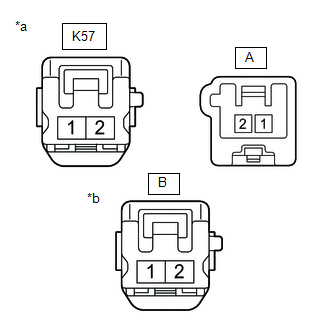
|
*a | Component without harness connected
(Seat Heater Assembly (Rear Seat Cushion Heater LH)) |
|
*b | Component without harness connected
(Seat Heater Assembly (Rear Seatback Heater LH)) |
(d) Apply auxiliary battery voltage and check the operation of the rear seat heater as shown in the table below.
NOTICE:
To
prevent the rear seat heater from overheating, be sure to disconnect
the auxiliary battery from the rear seat heater immediately after this
inspection is completed.
OK:
|
Auxiliary battery Connection |
Specified Condition |
|
Auxiliary battery positive (+) → Terminal K57-1 |
Rear seat heater operates (Temperature 36 to 44°C (96.8 to 111.2°F)) |
|
Auxiliary battery negative (-) → Terminal K57-2 |
CHECK THERMOSTAT OF SEAT HEATER ASSEMBLY (REAR SEAT CUSHION HEATER RH) (w/ Rear Seat Heater)
(a) Remove the seat heater assembly (rear seat cushion heater RH).
Click here

(b) Remove the seat heater assembly (rear seatback heater RH).
Click here 
(c)
Connect the C seat heater assembly (rear seat cushion heater RH)
connector and D seat heater assembly (rear seatback heater RH)
connector.
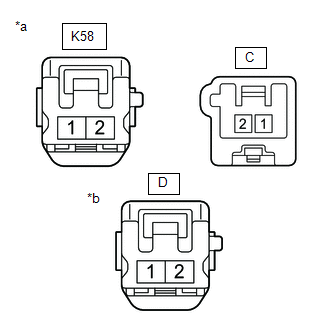
|
*a | Component without harness connected
(Seat Heater Assembly (Rear Seat Cushion Heater RH)) |
|
*b | Component without harness connected
(Seat Heater Assembly (Rear Seatback Heater RH)) |
(d) Apply auxiliary battery voltage and check the operation of the rear seat heater as shown in the table below.
NOTICE:
To
prevent the rear seat heater from overheating, be sure to disconnect
the auxiliary battery from the rear seat heater immediately after this
inspection is completed.
OK:
|
Auxiliary battery Connection |
Specified Condition |
|
Auxiliary battery positive (+) → Terminal K58-1 |
Rear seat heater operates (Temperature 36 to 44°C (96.8 to 111.2°F)) |
|
Auxiliary battery negative (-) → Terminal K58-2 |
Parts Location
PARTS LOCATION
ILLUSTRATION
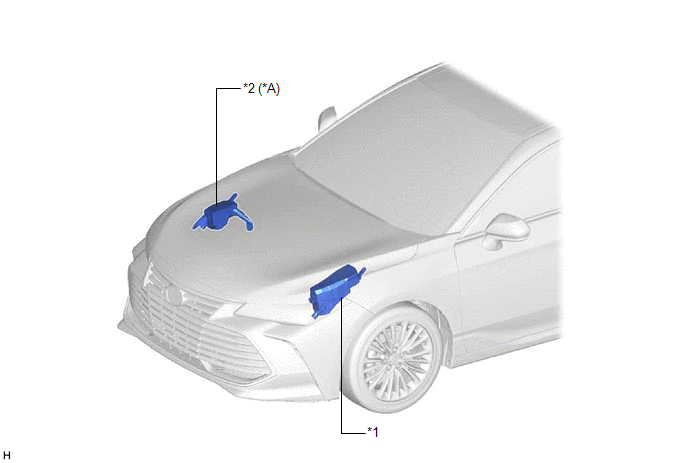
|
*A | w/ Rear Seat Heater |
- | - |
|
*1 | NO. 1 ENGINE ROOM RELAY BLOCK AND NO. 1 JUNCTION BLOCK ASSEMBLY
- S/HTR MAIN FUSE | *2 |
NO. 2 ENGINE ROOM RELAY BLOCK AND NO. 2 JUNCTION BLOCK ASSEMBLY
- S/HTR RR FUSE |
ILLUSTRATION
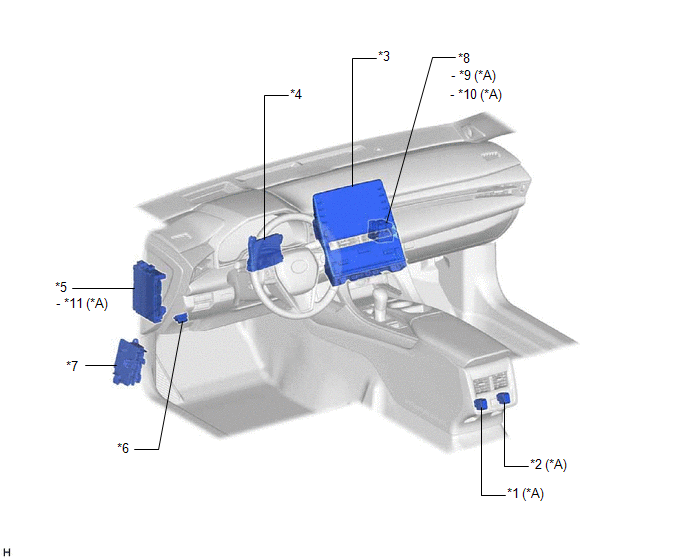
|
*A | w/ Rear Seat Heater |
- | - |
|
*1 | SEAT HEATER SWITCH (LH) |
*2 | SEAT HEATER SWITCH (RH) |
|
*3 | SEAT HEATER SWITCH (RADIO AND DISPLAY RECEIVER ASSEMBLY) |
*4 | AIR CONDITIONING AMPLIFIER ASSEMBLY |
|
*5 | INSTRUMENT PANEL JUNCTION BLOCK ASSEMBLY
- ECU-IG1 NO. 4 FUSE |
*6 | DLC3 |
|
*7 | NO. 4 RELAY BLOCK ASSEMBLY
- S/HTR F/R FUSE - S/HTR F/L FUSE |
*8 | NO. 3 RELAY BLOCK ASSEMBLY
- S/HTR F/R RELAY |
|
*9 | S/HTR R/R RELAY |
*10 | S/HTR R/L RELAY |
|
*11 | PANEL FUSE |
- | - |
ILLUSTRATION

|
*1 | FRONT SEATBACK HEATER ASSEMBLY RH |
*2 | FRONT SEATBACK HEATER ASSEMBLY LH |
|
*3 | FRONT SEAT CUSHION HEATER ASSEMBLY RH |
*4 | FRONT SEAT CUSHION HEATER ASSEMBLY LH |
|
*5 | SEAT HEATER CONTROL SUB-ASSEMBLY RH |
*6 | SEAT HEATER CONTROL SUB-ASSEMBLY LH |
ILLUSTRATION
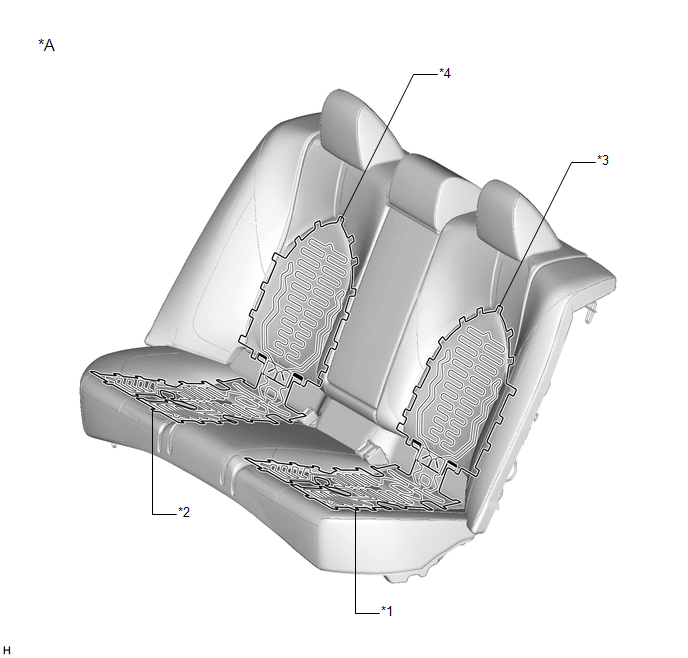
|
*A | w/ Rear Seat Heater |
- | - |
|
*1 | SEAT HEATER ASSEMBLY (REAR SEAT CUSHION HEATER LH) |
*2 | SEAT HEATER ASSEMBLY (REAR SEAT CUSHION HEATER RH) |
|
*3 | SEAT HEATER ASSEMBLY (REAR SEATBACK HEATER LH) |
*4 | SEAT HEATER ASSEMBLY (REAR SEATBACK HEATER RH) |
Precaution
PRECAUTION
PRECAUTION FOR DISCONNECTING CABLE FROM NEGATIVE AUXILIARY BATTERY TERMINAL
NOTICE:
When
disconnecting the cable from the negative (-) auxiliary battery
terminal, initialize the following systems after the cable is
reconnected.
|
System Name | See Procedure |
|
Lane Departure Alert System (w/ Steering Control) |
 |
|
Intelligent Clearance Sonar System |
|
Parking Assist Monitor System |
|
Panoramic View Monitor System |
|
Pre-collision System |
|
Lighting System (for HV Model with Cornering Light) |
Problem Symptoms Table
PROBLEM SYMPTOMS TABLE
NOTICE:
- If the auxiliary battery voltage becomes low, auxiliary battery load
control will operate in order to ensure sufficient power is supplied to
the power steering system. In this case, the seat heater system (for HV
model) may not operate.
HINT:
- Use the table below to help determine the cause of problem symptoms. If
multiple suspected areas are listed, the potential causes of the
symptoms are listed in order of probability in the "Suspected Area"
column of the table. Check each symptom by checking the suspected areas
in the order they are listed. Replace parts as necessary.
- Inspect the fuses and relays related to this system before inspecting the suspected areas below.
Seat Heater System |
Symptom | Suspected Area |
Link |
| Front seat heater does not operate for driver side and front passenger side seat |
Seat heater switch (radio and display receiver assembly) |
- |
| Air conditioning amplifier assembly |
- |
| S/HTR F/R relay |
- |
| Wire harness or connector |
- |
| Seat heater for front right seat does not operate |
Refer to the "Seat Heater for Front Right Seat does not Operate". |
 |
|
Seat heater for front left seat does not operate |
Refer to the "Seat Heater for Front Left Seat does not Operate". |
 |
|
Seat heater for rear left and rear right seat do not operate |
Air conditioning amplifier assembly |
- |
|
Seat heater for rear right seat does not operate |
Seat heater assembly (rear seat cushion heater RH) |
 |
|
Seat heater assembly (rear seatback heater RH) |
 |
|
Seat heater switch (RH) |
 |
|
S/HTR R/R relay | - |
|
Wire harness or connector |
- |
| Air conditioning amplifier assembly |
- |
|
Seat heater for rear left seat does not operate |
Seat heater assembly (rear seat cushion heater LH) |
 |
|
Seat heater assembly (rear seatback heater LH) |
 |
|
Seat heater switch (LH) |
 |
|
S/HTR R/L relay | - |
|
Wire harness or connector |
- |
| Air conditioning amplifier assembly |
- |
Seat Heater for Front Left Seat does not Operate
DESCRIPTION
When the seat
heater switch of the seat heater switch (radio and display receiver
assembly) is operated, the air conditioning amplifier assembly receives a
signal and operates the front seat heater.
WIRING DIAGRAM
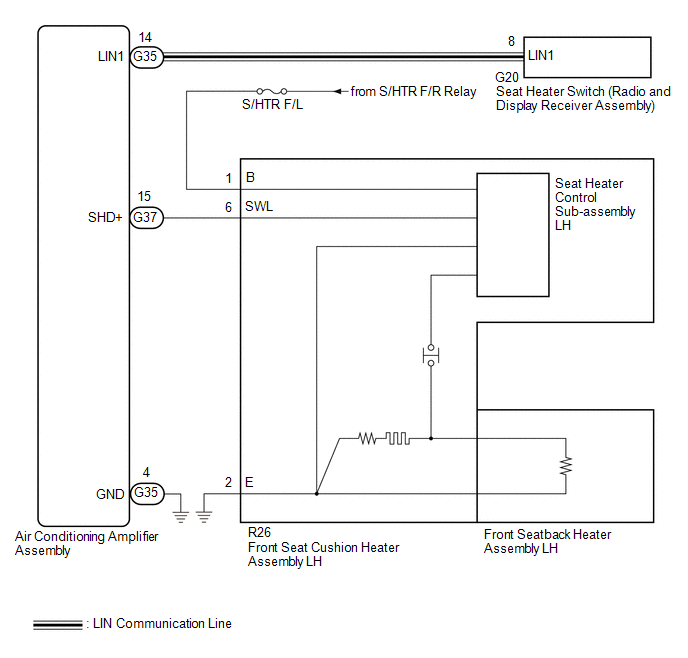
CAUTION / NOTICE / HINT
NOTICE:
- If the auxiliary battery voltage becomes low, auxiliary battery load
control will operate in order to ensure sufficient power is supplied to
the power steering system. In this case, the seat heater system (for HV
model) may not operate.
- Inspect the fuses for circuits related to this system before performing the following procedure.
PROCEDURE
(a) Clear the DTCs.
Click here 
Body Electrical > Air Conditioner > Clear DTCs
|
NEXT |
 | |
(a) Check for DTCs.
Click here 
Body Electrical > Air Conditioner > Trouble Codes
OK:
DTC B14B5 and B14C1 are not output.
| NG |
 | GO TO DIAGNOSTIC TROUBLE CODE CHART |
|
OK |
 | |
| 3. |
PERFORM ACTIVE TEST USING TECHSTREAM |
(a) Connect the Techstream to the DLC3.
(b) Turn the power switch on (IG).
(c) Turn the Techstream on.
(d) Enter the following menus: Body Electrical / Air Conditioner / Active Test.
(e) Perform the Active Test according to the display on the Techstream.
Body Electrical > Air Conditioner > Active Test
|
Tester Display | Measurement Item |
Control Range | Diagnostic Note |
|
Front Left Seat Heater |
Front seat LH side seat heater operation |
OFF or ON | - |
Body Electrical > Air Conditioner > Active Test
|
Tester Display |
| Front Left Seat Heater |
OK:
The seat heater operates normally.
| OK |
 | REPLACE SEAT HEATER SWITCH (RADIO AND DISPLAY RECEIVER ASSEMBLY) |
|
NG |
 | |
| 4. |
INSPECT FRONT SEATBACK HEATER ASSEMBLY LH |
(a) Remove the front seatback heater assembly LH.
Click here

(b) Inspect the front seatback heater assembly LH.
Click here 
| NG |
 | REPLACE FRONT SEATBACK HEATER ASSEMBLY LH |
|
OK |
 | |
| 5. |
CHECK HARNESS AND CONNECTOR (IG POWER SUPPLY - FRONT SEAT CUSHION HEATER ASSEMBLY LH - BODY GROUND) |
| (a) Disconnect the R26 front seat cushion heater assembly LH connector. |
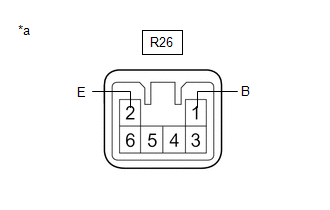 |
|
*a | Front view of wire harness connector
(to Front Seat Cushion Heater Assembly LH) | | |
(b) Measure the voltage and resistance according to the value(s) in the table below.
Standard Voltage:
|
Tester Connection | Condition |
Specified Condition |
|
R26-1 (B) - Body ground |
Power switch on (IG) |
11 to 14 V |
|
R26-1 (B) - Body ground |
Power switch off | Below 1 V |
Standard Resistance:
|
Tester Connection | Condition |
Specified Condition |
|
R26-2 (E) - Body ground |
Always | Below 1 Ω |
| NG |
 | REPAIR OR REPLACE HARNESS OR CONNECTOR |
|
OK |
 | |
| 6. |
CHECK HARNESS AND CONNECTOR (AIR CONDITIONING AMPLIFIER ASSEMBLY - FRONT SEAT CUSHION HEATER ASSEMBLY LH) |
| (a) Reconnect the R26 front seat cushion heater assembly LH connector. |
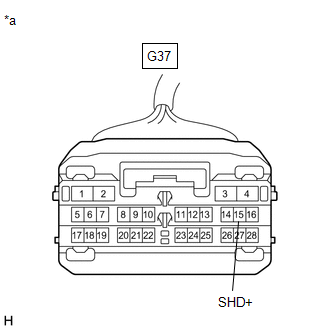 |
|
*a | Front view of wire harness connector
(to Air Conditioning Amplifier Assembly) | | |
(b) Disconnect the G37 air conditioning amplifier assembly connector.
(c) Measure the voltage according to the value(s) in the table below.
Standard Voltage:
|
Tester Connection | Condition |
Specified Condition |
|
G37-15 (SHD+) - Body ground |
Power switch on (IG) |
5 to 13 V |
| NG |
 | GO TO STEP 8 |
|
OK |
 | |
| 7. |
CHECK AIR CONDITIONING AMPLIFIER ASSEMBLY |
(a) Reconnect the G37 air conditioning amplifier assembly connector.
(b) Remove the air conditioning amplifier assembly with its connectors still connected.
Click here 
(c) Measure the voltage according to the value(s) in the table below.

|
*a | Component with harness connected
(Air Conditioning Amplifier Assembly) |
- | - |
Standard Voltage:
|
Tester Connection | Condition |
Specified Condition |
|
G37-15 (SHD+) - G35-4 (GND) |
Power switch on (IG), seat heater switch (radio and display receiver assembly) on (LO) |
Below 1 V |
| OK |
 | REPLACE FRONT SEAT CUSHION HEATER ASSEMBLY LH |
| NG |
 | REPLACE AIR CONDITIONING AMPLIFIER ASSEMBLY |
| 8. |
CHECK HARNESS AND CONNECTOR (AIR CONDITIONING AMPLIFIER ASSEMBLY - FRONT SEAT CUSHION HEATER ASSEMBLY LH) |
(a) Disconnect the R26 front seat cushion heater assembly LH connector.
(b) Measure the resistance according to the value(s) in the table below.
Standard Resistance:
|
Tester Connection | Condition |
Specified Condition |
|
G37-15 (SHD+) - R26-6 (SWL) |
Always | Below 1 Ω |
| OK |
 | REPLACE FRONT SEAT CUSHION HEATER ASSEMBLY LH |
| NG |
 | REPAIR OR REPLACE HARNESS OR CONNECTOR |
Seat Heater for Front Right Seat does not Operate
DESCRIPTION
When the seat
heater switch of the seat heater switch (radio and display receiver
assembly) is operated, the air conditioning amplifier assembly receives a
signal and operates the front seat heater.
WIRING DIAGRAM

CAUTION / NOTICE / HINT
NOTICE:
- If the auxiliary battery voltage becomes low, auxiliary battery load
control will operate in order to ensure sufficient power is supplied to
the power steering system. In this case, the seat heater system (for HV
model) may not operate.
- Inspect the fuses for circuits related to this system before performing the following procedure.
PROCEDURE
(a) Clear the DTCs.
Click here 
Body Electrical > Air Conditioner > Clear DTCs
|
NEXT |
 | |
(a) Check for DTCs.
Click here 
Body Electrical > Air Conditioner > Trouble Codes
OK:
DTC B14B5 and B14C0 are not output.
| NG |
 | GO TO DIAGNOSTIC TROUBLE CODE CHART |
|
OK |
 | |
| 3. |
PERFORM ACTIVE TEST USING TECHSTREAM |
(a) Connect the Techstream to the DLC3.
(b) Turn the power switch on (IG).
(c) Turn the Techstream on.
(d) Enter the following menus: Body Electrical / Air Conditioner / Active Test.
(e) Perform the Active Test according to the display on the Techstream.
Body Electrical > Air Conditioner > Active Test
|
Tester Display | Measurement Item |
Control Range | Diagnostic Note |
|
Front Right Seat Heater |
Front seat RH side seat heater operation |
OFF or ON | - |
Body Electrical > Air Conditioner > Active Test
|
Tester Display |
| Front Right Seat Heater |
OK:
The seat heater operates normally.
| OK |
 | REPLACE SEAT HEATER SWITCH (RADIO AND DISPLAY RECEIVER ASSEMBLY) |
|
NG |
 | |
| 4. |
INSPECT FRONT SEATBACK HEATER ASSEMBLY RH |
(a) Remove the front seatback heater assembly RH.
Click here

(b) Inspect the front seatback heater assembly RH.
Click here 
| NG |
 | REPLACE FRONT SEATBACK HEATER ASSEMBLY RH |
|
OK |
 | |
| 5. |
CHECK HARNESS AND CONNECTOR (IG POWER SUPPLY - FRONT SEAT CUSHION HEATER ASSEMBLY RH - BODY GROUND) |
| (a) Disconnect the R6 front seat cushion heater assembly RH connector. |
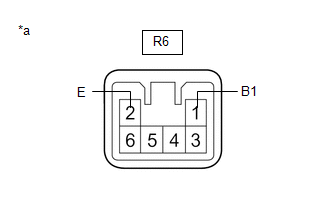 |
|
*a | Front view of wire harness connector
(to Front Seat Cushion Heater Assembly RH) | | |
(b) Measure the voltage and resistance according to the value(s) in the table below.
Standard Voltage:
|
Tester Connection | Condition |
Specified Condition |
|
R6-1 (B1) - Body ground |
Power switch on (IG) |
11 to 14 V |
|
R6-1 (B1) - Body ground |
Power switch off | Below 1 V |
Standard Resistance:
|
Tester Connection | Condition |
Specified Condition |
|
R6-2 (E) - Body ground |
Always | Below 1 Ω |
| NG |
 | REPAIR OR REPLACE HARNESS OR CONNECTOR |
|
OK |
 | |
| 6. |
CHECK HARNESS AND CONNECTOR (AIR CONDITIONING AMPLIFIER ASSEMBLY - FRONT SEAT CUSHION HEATER ASSEMBLY RH) |
| (a) Reconnect the R6 front seat cushion heater assembly RH connector. |
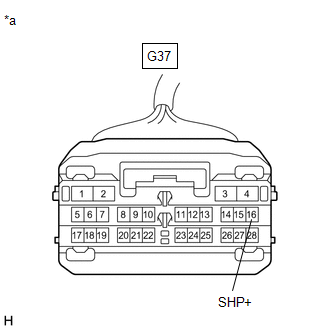 |
|
*a | Front view of wire harness connector
(to Air Conditioning Amplifier Assembly) | | |
(b) Disconnect the G37 air conditioning amplifier assembly connector.
(c) Measure the voltage according to the value(s) in the table below.
Standard Voltage:
|
Tester Connection | Condition |
Specified Condition |
|
G37-16 (SHP+) - Body ground |
Power switch on (IG) |
5 to 13 V |
| NG |
 | GO TO STEP 8 |
|
OK |
 | |
| 7. |
CHECK AIR CONDITIONING AMPLIFIER ASSEMBLY |
(a) Reconnect the G37 air conditioning amplifier assembly connector.
(b) Remove the air conditioning amplifier assembly with its connectors still connected.
Click here 
(c) Measure the voltage according to the value(s) in the table below.

|
*a | Component with harness connected
(Air Conditioning Amplifier Assembly) |
- | - |
Standard Voltage:
|
Tester Connection | Condition |
Specified Condition |
|
G37-16 (SHP+) - G35-4 (GND) |
Power switch on (IG), seat heater switch (radio and display receiver assembly) on (LO) |
Below 1 V |
| OK |
 | REPLACE FRONT SEAT CUSHION HEATER ASSEMBLY RH |
| NG |
 | REPLACE AIR CONDITIONING AMPLIFIER ASSEMBLY |
| 8. |
CHECK HARNESS AND CONNECTOR (AIR CONDITIONING AMPLIFIER ASSEMBLY - FRONT SEAT CUSHION HEATER ASSEMBLY RH) |
(a) Disconnect the R6 front seat cushion heater assembly RH connector.
(b) Measure the resistance according to the value(s) in the table below.
Standard Resistance:
|
Tester Connection | Condition |
Specified Condition |
|
G37-16 (SHP+) - R6-6 (SWR) |
Always | Below 1 Ω |
| OK |
 | REPLACE FRONT SEAT CUSHION HEATER ASSEMBLY RH |
| NG |
 | REPAIR OR REPLACE HARNESS OR CONNECTOR |
System Description
SYSTEM DESCRIPTION
FRONT SEAT HEATER
(a)
By operating the seat heater switch (radio and display receiver
assembly), the temperature can be controlled within the range of 36 to
44°C (96.8 to 111.2°F).
HINT:
The operating temperature range is that detected by the thermistor, not at the seat surface.
(b) The seat heater switch (radio and display receiver assembly) indicator lights indicate seat heater operating status.
(c) The seat heaters of both seats are controlled by the seat heater control sub-assemblies.
REAR SEAT HEATER (w/ Rear Seat Heater)
(a) By operating the seat heater switch, the temperature can be controlled within the range of 36 to 44°C (96.8 to 111.2°F).
(b) The seat heater switch indicator lights indicate the seat heater operating status.
Terminals Of Ecu
TERMINALS OF ECU
CHECK AIR CONDITIONING AMPLIFIER ASSEMBLY

(a) Disconnect the G35 air conditioning amplifier assembly connector.
(b) Measure the voltage and resistance according to the value(s) in the table below.
HINT:
Measure the values on the wire harness side with the connector disconnected.
|
Terminal No. (Symbol) | Wiring Color |
Terminal Description | Condition |
Specified Condition |
|
G35-2 (IG+) - Body ground |
LA-GR - Body ground | IG power supply |
Power switch off | Below 1 V |
|
G35-2 (IG+) - Body ground |
LA-GR - Body ground | IG power supply |
Power switch on (IG) |
11 to 14 V |
|
G35-4 (GND) - Body ground |
W-B - Body ground | Ground |
Always | Below 1 Ω |
(c) Reconnect the G35 air conditioning amplifier assembly connector.
(d) Measure the voltage and check for pulses generation according to the value(s) in the table below.
|
Terminal No. (Symbol) | Wiring Color |
Terminal Description | Condition |
Specified Condition |
|
G37-16 (SHP+) - G35-4 (GND) |
LG - W-B | Front seat heater control signal |
- Power switch on (IG)
- Seat heater switch (radio and display receiver assembly) on (LO)
(heater position)
| Below 1 V |
|
G37-15 (SHD+) - G35-4 (GND) |
BE - W-B | Front seat heater control signal |
- Power switch on (IG)
- Seat heater switch (radio and display receiver assembly) on (LO)
(heater position)
| Below 1 V |
|
G37-27 (HTR2) - G35-4 (GND) |
L - W-B | Rear seat heater control signal |
- Power switch on (IG)
- Rear seat heater switch (LH) on
| Below 1 V |
|
G36-7 (HTR1) - G35-4 (GND) |
W - W-B | Rear seat heater control signal |
- Power switch on (IG)
- Rear seat heater switch (RH) on
| Below 1 V |
|
G35-14 (LIN1) - Body ground |
LG - Body ground | Front seat heater switch signal |
Power switch on (IG) |
Pulse generation |
|
G36-28 (SW 2) - Body ground |
G - Body ground | Rear seat heater switch signal |
- Power switch on (IG)
- Rear seat heater switch (LH) on
| 11 to 14 V |
|
G36-26 (SW 1) - Body ground |
R - Body ground | Rear seat heater switch signal |
- Power switch on (IG)
- Rear seat heater switch (RH) on
| 11 to 14 V |
CHECK SEAT HEATER SWITCH (RADIO AND DISPLAY RECEIVER ASSEMBLY)

(a) Disconnect the G20 seat heater switch (radio and display receiver assembly) connector.
(b) Measure the voltage and resistance according to the value(s) in the table below.
HINT:
Measure the values on the wire harness side with the connector disconnected.
|
Terminal No. (Symbol) | Wiring Color |
Terminal Description | Condition |
Specified Condition |
|
G20-2 (IG+) - Body ground |
GR - Body ground | IG power supply |
Power switch off | Below 1 V |
|
G20-2 (IG+) - Body ground |
GR- Body ground | IG power supply |
Power switch on (IG) |
11 to 14 V |
|
G20-6 (GND) - Body ground |
W-B - Body ground | Ground |
Always | Below 1 Ω |
(c) Reconnect the G20 seat heater switch (radio and display receiver assembly) connector.
(d) Check for pulses according to the value(s) in the table below.
|
Terminal No. (Symbol) | Wiring Color |
Terminal Description | Condition |
Specified Condition |
|
G20-8 (LIN1) - Body ground |
LG - Body ground | Seat heater switch signal |
Power switch on (IG) |
Pulse generation |











